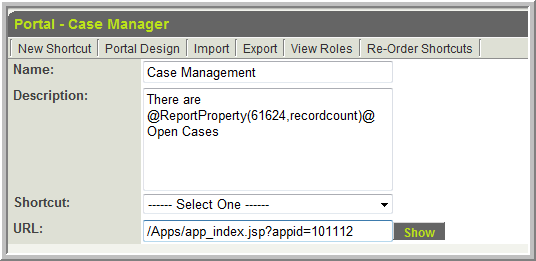Report Variables
This article describes the Variables that can be used to display report data, or properties of reports.
For details on Variables that can be used when creating reports see Using Variables in the Report Builder.
Contents
Syntax
- @ReportProperty(reportid,property)@
Where:
- reportid is the system ID for the report (see Determining the reportid). The ReportProperty syntax also supports the Report Name, but you must ensure the Report Name does not include any special characters.
- property can be:
- recordcount - Count of the number of records within a specified report
- csvdata - Report data, with each field separated by commas
- exportdata - Report data, formatted as defined in the Custom Export settings of the Report
- exportrawdata - Report data, without any formatting
Note:
- ReportProperty is case sensitive. Using reportproperty will not work.
Using ReportProperty on reports with a Group By
- In order to use a ReportProperty on a report which has a group by clause, you need to add a distinct clause to the ReportProperty syntax.
@ReportProperty(reportid,property,distinct(fieldname))@ Example: If a report is grouped by the tracking id, then your ReportProperty syntax would be @ReportProperty(reportid,property,distinct(opportunityid))@
You can also pass criteria into the ReportProperty call. See Including Criteria in ReportProperty.
Record Count
recordcount can be used:
- In a Web Page View or as a Read Only - System Variable to display a record count
- As part of Submit Logic to ensure a certain condition is met prior to submission of a record.
- Included in the title of a Portal shortcut to indicate how many records are at a given status (for example)
Examples:
- To generate the number of records (equivalent to the number of rows in the report) for report with ID 12345
@ReportProperty(12345,recordcount)@
Will display as:
CSV Data
When using the csvdata report variable, the variable will be replaced with data from the specified report, as comma separated values.
- @ReportProperty(reportid,csvdata)@
The csvdata variable can be used in a Web Page View or Read Only - System Variables custom field, or be included in the body of a Workflow message.
csvdata is most often used within the body of a plain-text workflow e-mail.
When using the csvdata variable the header and footer defined on the Report Export page will be used.
Export Data
When using the Exportdata report variable, the variable will be replaced with data from the specified report, in the format defined by the custom export template.
- @ReportProperty(reportid,exportdata)@
The exportdata variable can be used in a Web Page View or Read Only - System Variables custom field, or be included in the body of a Workflow message.
Most often exportdata is used with report export settings defined as HTML.
Export Raw Data
When using the Exportrawdata report variable, the variable will be replaced with data from the specified report, without any formatting applied.
- @ReportProperty(reportid,exportrawdata)@
The exportrawdata variable can be used in a Web Page View or Read Only - System Variables custom field, or be included in the body of a Workflow message.
Notes
- When using any of the ReportProperty variables (recordcount, exportdata and csvdata) the object ID (opportunityid, eventid, userid, etc) will be passed to the report processor. If the specified report includes the variable: @objectid@, it will be replaced by the object ID of whichever object (Level 1, Level 2, Contact, etc) called the ReportProperty attribute.
